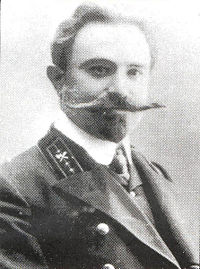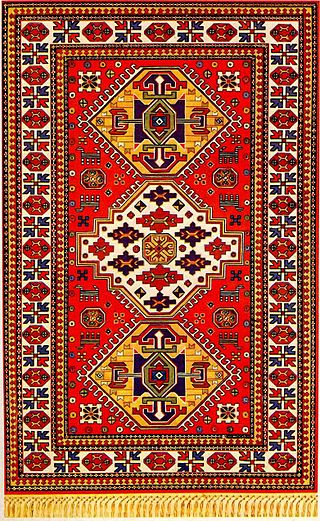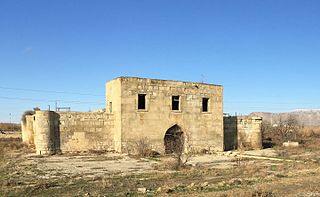The Absheron Carpet Weaving School is one of the Azerbaijani carpet weaving schools. [1] [2] The school covers the Absheron villages: Goradil, Novkhani, Surakhani, Nardaran, Bulbul, Fatmai, Mardakan, Qala, Khila, as well as the Khyzy region. Such centers of carpet weaving as Gadi, Khil, Kesh, Fyndygan and others are also known. [3] [4]
The carpets are characterized by softness and intensity of colors, original geometric patterns. The geometric patterns and images of plants are often associated with the decorations of these carpets.
Most of the carpets bear the names of the places and villages where they were woven. Examples of such carpets are such famous compositions as Khilabuta, Hila-Afshan, Novkhani, Surakhani, Kala, Baky, Goradil, Fatmai, Fyndygan, Gadi, etc. [5] One of the best products of the Baku carpet weaving school is the "Zili" carpet, woven in a manner similar to the "Shadda" carpet. [5]

A Persian carpet or Persian rug, also known as Iranian carpet, is a heavy textile made for a wide variety of utilitarian and symbolic purposes and produced in Iran, for home use, local sale, and export. Carpet weaving is an essential part of Persian culture and Iranian art. Within the group of Oriental rugs produced by the countries of the "rug belt", the Persian carpet stands out by the variety and elaborateness of its manifold designs.

Shaki is a city in northwestern Azerbaijan, surrounded by the district of the same name. It is located in the southern part of the Greater Caucasus mountain range, 240 km (150 mi) from Baku. As of 2020, it has a population of 68,400. The center of the city and the Palace of Shaki Khans were inscribed in the UNESCO World Heritage List in 2019 because of their unique architecture and history as an important trading center along the Silk Road.

Mirza Shafi Vazeh was an Azerbaijani poet and teacher. Under the pseudonym "Vazeh", which means "expressive, clear", he wrote in both Azerbaijani and Persian, developing the traditions of poetry in both languages. He compiled the first anthology of Azerbaijani poetry and a Tatar-Russian dictionary for the Tiflis gymnasium with Russian teacher Ivan Grigoriev.

Nikolay Georgievich Bayev was an Armenian architect, who mainly worked in Baku in the 1910s and in Soviet Armenia since the 1920s.
Azerbaijani art is the art created by Azerbaijanis. They have created rich and distinctive art, a major part of which is applied art items. This form of art rooted in antiquity, is represented by a wide range of handicrafts, such as chasing (metalworking), jewellery-making, engraving, carving wood, stone and bone, carpet-making, lacing, pattern weaving and printing, and knitting and embroidery. Each of these decorative arts is evidence of the culture and the abilities of the Azerbaijan nation, and are very popular there. Many interesting facts pertaining to the development of arts and crafts in Azerbaijan were reported by merchants, travellers and diplomats who visited these places at different times.

Nizami Street is a large pedestrian and shopping street in downtown Baku, Azerbaijan, named after classical Persian poet Nizami Ganjavi.

Stone sculptures of horses and sheep – are zoomorphic headstones, spread in the South Caucasus, Western Armenia and Iranian Azerbaijan, the main part of which is dated back to the 13th-19th centuries.

The boteh, is an almond or pine cone-shaped motif in ornament with a sharp-curved upper end. Though of Persian origin, it is very common and called buta in India, Azerbaijan, Turkey and other countries of the Near East. Via Kashmir shawls it spread to Europe at least in 19th century, where patterns using it are known since 1960s as paisleys, as Paisley, Renfrewshire in Scotland was a major centre making them.

Gasimushaghi carpets are Azerbaijani pile carpets of the Karabakh school of the Jabrayil group.

Jalil Mammadali oghlu Javadov was a Soviet Azerbaijani commander, counter admiral (1968), first admiral of Azerbaijan and Turkic-muslim world of the USSR, chairman of Republic Committee of Army, Aviation, Volunteer Assistance Society of Azerbaijan SSR (1954-1971), member of the 5th convocation (1959-1963) of the Supreme Soviet of the Azerbaijan SSR.
History of Barda includes the history of the Azerbaijani city of Barda from the medieval period to the present day.

The ancient Muslim cemetery is a medieval cemetery located until the second half of the 19th century in the northwest of the Baku fortress. During the construction work on the territory of the cemetery, pre-Muslim burials and a cemetery of 12-14 and earlier centuries were uncovered.

"Aghajly" - belonging to the Tabriz type. These carpets got their name not from the place of their production, but in accordance with their composition. Thus, the composition of the middle field of these carpets mainly consists of one or more trees and bushes and, in rare cases, of a group of trees intended to represent a garden or forest. The trees are represented differently. The spring or autumn trees are usually in bloom or with fruits, and sometimes these are cypress, willow, weeping willow and other ornamental trees.

"Bakhshayish" - Northwest Persian carpets belonging to the Tabriz type. They got their name from the village Bakhshayish, located 70 kilometres northeast of Tabriz. Until the recent past, this village was the centre of the household items of carpet manufacture production, including chuval, blankets, chuval, dzhurab, as well as lint-free kilim and palas carpets.

Borchaly describes a sub-category within the Gazakh group of Azerbaijani carpets, even though the region from which they originate is now within Georgia. The name of this carpet is associated with the name of the Borchaly region, located to in southeastern Georgia close to the border of Gazakh district, Azerbaijan. Large villages of this region including Gurdlar, Akhurly, Kachagan, Sadakhly (Sashikhly), Dashtepe and Lembeli were once famous for carpet weaving, though in recent decades the art of carpet weaving has almost entirely died out, leaving only two known villages where Borchaly style carpets are still woven: Kosalar and Mughanlo. The population of Borchaly including the above-mentioned villages consists mainly of ethnic Azerbaijanis.

The Sangachal caravanserai is a medieval caravanserai located near the Sangachal village in the Garadagh district of Baku, Azerbaijan, 45 km far from Baku, on the old caravan route Baku - Salyan. Since the 19th century, the indicated caravan route has lost its commercial significance and in this regard, the caravanserai has ceased to be used.

Armenian-Azerbaijani cultural relations are relations between two ethnic groups in terms of their language and culture.

"Khila-Afshan" - pile carpets belonging to the Baku group of Absheron carpet weaving school.
Ferdinand Lehmkuhl was an engineer-technologist and architect.